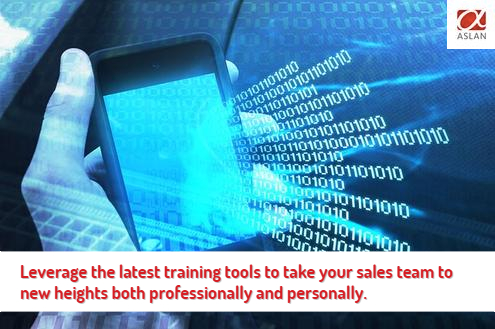Tools for Teaching
By ASLAN Training
December 19, 2014
3 min read

Technology has affected many fields today, especially the world of education and training. Technology is more than just trying to explain to your grandfather what exactly “the Facebook” is, it is also how many today prefer to learn. Today’s businesses depend on technology to not only make sales training less expensive, but more efficient. How can companies meet this goal? Two distinct ways: properly implementing sophisticated tech tools for learning and development, and then going back and measuring the results of this training with key performance indicators (KPIs).
The Best Tech Tools For Learning
The days of teachers scribbling notes on a chalkboard are behind us. Today, the training industry is moving rapidly towards eLearning. In 2011, $35.6 billion was spent on self-paced eLearning tools. Just two years later, in 2013, that number was up to $56.2 billion; by 2015, it is expected to double. Sales eLearning is valuable for companies because it allows them to hold training that their employees can complete at their own pace.
What are some of these eLearning tools? Litmos LMS is a popular tool for training because of its support for multiple devices and easy-to-use platform. KMI Learning is another tool that can be used for multiple kinds of learning campaigns. There are plenty of options available depending on what your needs are and what your budget is for eLearning.
Additionally, the impact of eLearning is relatively measurable, thanks to the use of KPIs.
Key Performance Indicators (KPI): What They Are And How To Use Them
KPIs might sound like a measurement a mechanic would use, but in reality, it is an important tool for any business to determine sales training effectiveness. These statistics measure areas where a company is looking to improve their operation. Comparing KPI results before and after your training is an excellent way to tell just how effective the training was for the people involved.
What are some of the most common KPIs? One of the best things about the use of KPIs with tech tools for learning is that they can be tailored to the needs of a specific company. Some of the most common KPIs include:
• Training cost per employee – This is a simple measure of how much your training costs.
• Completion rate – How many people are taking the training?
• Employee competency rate – How many at your company have the skills needed to perform their job properly? You will need to come up with your own unique tests and metrics to measure competency.
• Training perception rate – How many people at the company think that this training was valuable?
These are just a few examples of KPIs that are commonly used for training purposes. Remember to not overwhelm your team, however. Davi Ngo at HRvinet.com says that you should limit yourself to three to seven KPIs per process or function.
How The Big Names Do It: An Example From PwC
PricewaterhouseCoopers, one of the biggest professional services companies in the world, was facing some challenges with training delivery models. Andrew Wolff, Educational Methods Leader at PwC, wrote in 2011 that PwC’s early administrative training systems were not setup to handle mixed learning methods, and that vendor models and platforms weren’t scaling the right way. How did PwC respond? In short, by experimenting with technological learning tools to come to the conclusion that the most important facet of training was allowing people to come together to learn, whether that learning occurred in person or virtually.
With the right kind of tech tools for learning, your business can improve its sales training and minimize training costs. ASLAN can help you leverage the latest training tools to take your sales team to new heights both professionally and personally. We work closely with our clients to help them develop customized training regimens that align closely with their organizational goals and allow their sales teams to enjoy better performance. Contact ASLAN to see if our technology offering is a good fit for your team and how we can help your organization improve its technological learning.
ASLAN for Life. Teaching is a gift that goes well beyond the workspace, so look to tools and opportunities that will help you give back and share beyond your 8 to 5.
Unlock Your Team's Full Sales Potential
Questions? Watch our CEO, Tom Stanfill, address our frequently asked questions below.

